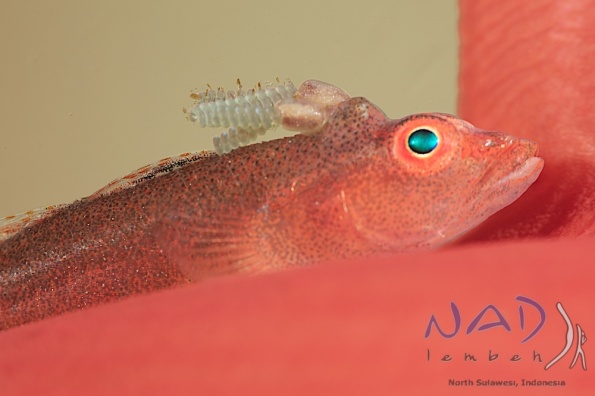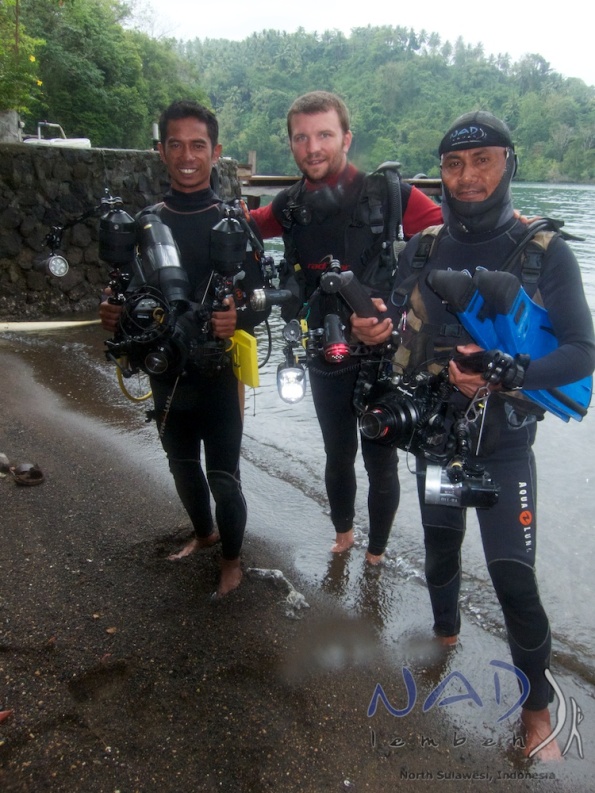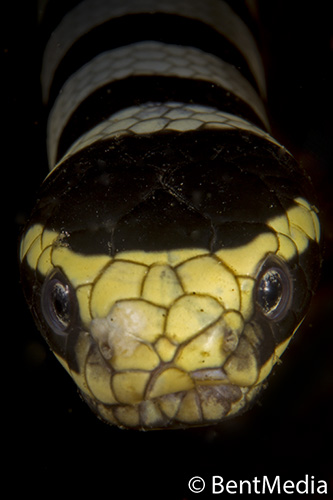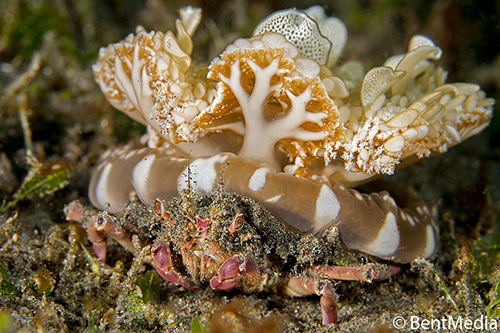Archive
Brain Suckers!
Following up to Bent’s enthusiasm for all things parasitic, i saw a parasitic copepod on a goby today at Nudi Falls, this one was on a soft coral so was in a nice position to shoot near to the sand.

A Parasitic Copepod sucking the brain juice from an unsuspecting Goby – note the size of the lump on the head!
Once I took a photo or two I noticed a pulsation in the body of the Copepod which looked like a peristaltic action to take fluids (food / brain juice / magical powers) from the host. I managed to get some video of it so you can take a look below:
The Gobies had a patch of eggs, so the presence of the parasite is not detrimental enough to prevent procreation, but it stall is a pretty gruesome way to live your life! Lembeh seems to be full or parasites these days, so when you are visiting keep checking for more smaller things on the smaller thing that is living on the bigger thing.
Masters of disguise
Well, as Lembeh must be the frogfish capital of the world, and frogfish are some of my favourite critters, I think that frogfish actually merits another blog entry. So here it is.
Frogfish are probably most known for their built in bait, an illicium or “fishing rod” that is topped with the esca, the worm- or shrimplike lure it self. The illicium and esca are formed from the foremost rays of the anterior dorsal fin, and can be moved in different directions in front of the mouth when prey comes close enough.
Frogfish belong to the family Antennariidae in the order Lophiiformes, which among others also include the supercool deep water anglerfish with lures that are shining with light. With a few exceptions, the most notable being the Sargasso frogfish, frogfish are mostly shallow water fish, living among rubble, sea weed, coral heads and other underwater structures that can aid the frogfish in hiding their outline from prey and predators.
In Lembeh strait a number of species are found. I have seen eight or nine species in Lembeh, but there are probably one or two more around.
Frogfish are notoriously hard to determine to species. Many species come in different colors, so color is at best a weak clue to what they are. Colors seem to change with background, making camouflage excellent, but on the other hand not helping very much in species determination.
A combination of habitat, body shape, and, maybe most important, characteristics of the lure can most often be used to at last narrow it down to a couple of likely names. A few, however, such as the hairy frogfish with it´s wormlike lure and the warty frogfish with it´s warty exterior are very characteristic and often easy to name. Others, such as the hispid, the painted and the giant (also called Commersons) frogfish are not to hard to determine if the lure is visible.
Then there are a number of frogfish with lures that are hard to see and quite similar markings that I find pretty hard to determine to species underwater.
And finally, Lembeh is home to at least one undescribed species, which has not been named by scientists yet.
The lure of the frogfish indicates that frogfish are specializing on fish as prey. With a few exceptions, fish is exactly what frogfish eat. When a small fish comes close to the frogfish, the lure is waved in an enticing way in front of the mouth of the frogfish. The prey fish will often be conned into believing that it is the luckiest day in its life, which most often is the last feeling the prey fish will have. When the prey comes close enough, the frogfish extends its enormous mouth, inhaling a lot of water and a small, and highly likely very surprised, fish. The mouth movement of the frogfish is so quick that scientists have problems explaining how that speed is even possible.
The teeth of frogfish are very pointed and directed backwards towards the interior of the mouth. Thus, anything caught by a frogfish will have a really hard time escaping, while the direction of the teeth will allow the frogfish to move the prey inside the mouth. Frogfish are extremely elastic, being able to swallow prey as large as themselves.
Frogfish have three ways of moving. First, like most fish, they can swim through the water column using their caudal fin. They can also use a water jet by expelling water through the small gill openings behind the pelvic fins. Finally, frogfish can more or less gallop over sandy bottoms, in a rather ungraceful running motion resembling what a cross between a sea lion, a football and a horse would look like in full speed.
So, now I am of running an ecology/photo course in the Red sea. Those of you that follow this series will probably have the next entry available in a couple of weeks.
Underwater Tribe Photo Workshop
Mike Veitch and Luca Vaime along with NAD Lembeh Resort are proud to announce our First Annual “Underwater Tribe/NAD Lembeh Photo Workshop” on 15-20th April 2013. This five night package is the perfect opportunity for you to learn photography from some of the worlds top underwater photography instructors while diving in the worlds premiere muck diving location! Join a group of like minded photo students at NAD Lembeh Resort and participate in our “Photography from A-Z” workshop where we include everything from the basics of underwater photography up to and including “advanced tips from the pros”. This workshop style week is perfect for everyone from beginners to experienced photographers who are looking for tips to take them to the next level. Topics covered include: “Understanding F-stops, Shutter Speed, and ISO”, “Using Strobes Underwater”, “Composition”, and “Creating a Workflow that Works”. As the week progresses we will discuss: Playing with Light, Diving with a Model, and Super Macro. Each student will receive one on one photo critiquing of the days dives in order to understand what went right and what went wrong. We will also dive “one on one” with each participant in order to help with strobe positioning and camera settings underwater.
The daily schedule will include two morning boat dives followed by lunch, a photo seminar, and an afternoon boat or shore dive. During the evenings we will work with individual students in order to critique their images of the day and present multi media presentations after dinner. Working closely with NADs top notch dive guides, we will find and photography the best that Lembeh Strait has to offer.
There are limited spaces available for this trip so please sign up soon for your chance to join us on this fun filled and educational trip to “the critter capital of the world, Lembeh Strait”!
For pricing details, further information, and booking please visit http://www.facebook.com/underwatertribe or send an email to info@underwatertribe.com
Trying out some new toys.
I could be posting about the Hairy Octopus, billions of Blue Rings, Wonderpus, Bumblebee Shrimps, Harlequins, Ambon Scorpion Fish, Hairy & Green Shrimps etc, but im too busy to go out taking pictures and im so out of practice it will be embarrassing to compare them to Bent‘s Pictures.
In the mean time, Paulus and Joni were able to go out yesterday afternoon and try getting to grips with some different cameras. They were using a Canon 7D in a Nauticam, a Canon S95 in a Canon Housing, and a Canon 5Dmk3 in an Aquatica. We headed out on the housereef and within a few minutes they found a mantis with eggs in about 3 m. So after a while i signaled to them that i would go to the wreck and leave these two highly experienced guides to finish off with the Mantis and then meet up with me at the wrecks.
I happily started taking some snoot pictures at the wreck and got so engrossed I lost track of time, about 30 minutes passed and they still hadn’t arrived. It turns out the two muppets were playing around with the camera so much they had lost their reference points and swum in the wrong direction (about 200m away!). So for anyone that has got lost during a self guided housereef dive at NAD, you don’t need to feel bad, some of the best guides in Lembeh also get lost when distracted with taking pictures!
Eventually when we met up again, they made some attempts at Lembeh Sea Dragon Shots. Next time they are only going to be allowed to shoot some of the easier things, the hit rate of good shots was a little low.
One thing that I found interesting was that both of them only took about 30 pictures between them, if it wasn’t going to be a good shot they didn’t even bother to pull the trigger. Many people only shot like that when they had film in their camera. They also wanted to to the new ‘Shoot 5’ rule that we have been using for the last month, shoot 5 pictures nice and slowly then let someone else get 5 whilst you review. It makes your pictures a lot better in the end as you are forced to check and avoid silly errors, and stops too much unnecessary flashing of the critters.
Soon the other guides will be finished with their guests and it will be their turn to start the learning process!
Deadliest snakes in the world?
I posted the following picture of a yellow lipped sea krait, Laticauda colubrina, on a couple of web sites after my last visit in Lembeh.
Among comments, several was so sure of the extreme danger I was subject to while taking the picture that they felt it worthwhile to actually write and advice me not to get that close to such a deadly creature, or the second most deadly snake in the world as one comment described it. That is of course very considerate, and I appreciate that to me unknown people actually worry about my well being, but in this case it is not really warranted. In my day job I sometimes handle snakes, and while I am pretty careful handling most terrestrial venomous snakes such as pit vipers, I am pretty relaxed about the underwater snakes, or at least sea kraits.

Wagler´s pit viper. While rarely deadly, it is seriously problematic to be bitten by. Picture not from Lembeh
That said, most marine snakes have extremely potent venom. So am I an idiot without any consideration of danger (think James Bond meets Chuck Norris), or is there more to the risk of being close to a snake than just the potency of the venom per se?
Well, first of all, humans are extremely bad at doing rational risk evaluations. One relevant example in the context of diving is of course the risk of being killed by a shark, which is many orders of magnitude less than other risks, such as the risk of being killed in a traffic accident, we accept daily. Even toasters are on a global level far more dangerous than sharks, but I have yet to meet a person that questions my sanity when I put toast in a toaster. Not so when I give talks on marine ecology, when I show pictures with sharks, the audience more or less always are pretty certain that a miracle saved me from being torn to pieces by the shark, even if it is a picture of white tip reef shark, being below hamsters or rats on my list of dangerous creatures!
Still there is the issue of the potency of the marine snake venom? How should that enter into a rational risk evaluation? The risk of actually being hurt, or even dying, of a particular snake´s bite is the product of a number of factors. Included in those factors are the risk of meeting the snake, risk of being bitten once having met the snake, risk of the bite actually penetrating the skin, the risk of being envenomed once being penetrated by the fangs, the amount of venom being transferred once being envenomed, the potency of the venom and the size and health status of the person being bit. So how does the banded sea kraits, such as the yellow lipped krait pictured here, score on such a calculation.
The risk of meeting the yellow lipped sea krait (or chance, from my perspective) is quite high. I see them approximately every 25th dive in Southeast Asia, so if one does a fair amount of diving, one will definitely run into the snakes. The risk of being bitten once having met the snake is extraordinarily low on the other hand. The only information I have on bites by the sea kraits is that fishermen entangling the snakes from nets have sometimes been bitten. Also there is some anecdotal evidence that the snakes can be aggressive if they feel that their way to the surface is blocked (they breathe air as all other snakes). Sea kraits have rather small teeth, so given that most divers wear wet suits, a bite would rarely if ever penetrate the suit. I have no specific information on the rate of envenomation once being penetrated, but many snakes do not use their costly venom very often in defensive actions. Also, given that venom is transferred, there seems to be quite some variation in the amount injected.
The potency of the venom in general, however, is very high for sea snakes. Finally, I am big and quite healthy. So, in conclusion, for yours truly, the combined risk of being killed by a banded sea krait seems to be quite low. Of course your calculation might differ markedly, so do not take this blogg entry as anything else than an example of my very own way of accounting for risk.
It should also be emphasised that there are many other sea snakes that scores much higher on the aggressiveness and tooth size factor above. At least one of those looks very much as the banded krait, so mistakes in identification can be made even by very experienced herpetologists. So even if the kraits are very docile, it might overall be good advice for most people to be a little bit careful around sea snakes.
Commensal Bryaninops gobies
For some reason certain animals are on the “cool” list that everyone wants to see and photograph and others are placed on the “not so cool” list and get ignored by most divers and photographers. Scarcity and cuteness seems to be two important factors determining the popularity of an animal. Despite not really ticking either the scarce or the cute box, due to their interesting life style the gobies of the genus Bryaninops have a long time been on my favourite list, and I more or less never pass a wire coral without checking it out for a goby or two.
Few other divers seem to find them very interesting, so I mostly get to have the wire corals and the gobies more or less for myself. This time in Lembeh, Paulus, my excellent guide, knowing about my interest in parasites, in the beginning of my stay showed me a couple of Bryaninops with the characteristic copepod parasites that many of these gobies carry, with the gobies living on other animals that I did not normally associate the gobies with.
During the weeks I stayed, I found gobies on a lot of different sedentary animals, more or less always colour matching the animal the goby associate with.
The Bryaninops gobies are found as commensals on different coral groups as well as sponges, sea squirts, sea stars and even on Halimeda algae.
The pelvic fins of the gobies are more or less adapted to be a disc capable of sucking the goby to its host during currents.
They never move far from their host, and can often be seen moving quickly around on the surface of the host, feeding on small zooplankton drifting by in the current.
Being commensal means that the interaction between two animals are neutral for one of the, in this case the host. The other partner, in this case the goby, of the interaction receives some benefit of being in a commensal relationship. There is no doubt that commensal gobies receive benefits by living on their hosts. The gobies settle as small larvae on their hosts and change colour to match the host during ontogeny.
Obviously such a colour match leads to some kind of concealment for the goby which otherwise has no protection against predators. When detected the gobies also use their hosts as hiding place, moving quickly to the other side of the host.
It is, however, not really clear that the hosts are unaffected by the interaction. At least one of the species, the common and wide spread wire coral goby Bryaninops yongei, lays their eggs on a patch of the wire coral where the gobies have cleared the coral from living polyps. Thus, at least in this case, it is unlikely that the coral is not negatively affected, and the relationship then should rather be classified as a parasitic interaction. On the other hand the goby might protect the coral from coralivores, thus mitigating the cost of the lost polyps somewhat.
Many new species of those gobies are now being recorded by goby experts from different parts of the world. The diversity of commensal gobies in Lembeh is probably quite high judging by the number of different gobies of slightly different shapes I saw on a number of different hosts during my two week stay, and I would not be surprised if there was one or two undescribed species among them. It will require a goby specialist to really understand what species are present here in Lembeh, so at least I, not that much into goby taxonomy, will have to enjoy the active and often quite beautiful fish without really knowing what specific species it is. On the other hand, with many other groups of high diversity in Lembeh, that happens quite often here, so one just have to get used to it!
Lovely Lembeh Video
Here is a Video Shot by Dustin Adamson took back in April. Dustin shot this with a Canon 5dMkii and the 100mm lens:
Congratulations to Dustin for editing such a wonderful piece.
Carrier crabs
The Aer Bajo dive sites are to me the essence of Lembeh diving. For me an optimal dive plan would include Aer Bajo on at least one dive every day! Sandy, somewhat silty slopes, initially giving the impression of not to many animals around, but always delivering something special. Furthermore, well into the dive, the count of critters almost always go up and on a good day there can be loads of stuff to see. Aer Bajo critters such as mimic and coconut octopus, Ambon scorpionfish and the likes are often found on the slopes down to around 20-something meters, with not much being seen in the shallows.
Aer Bajo dives often start from the boat which is moored in the shallows at around 5 m. Following briefings, after hitting the water, a somewhat uneventful short swim is to be done over the flat sand part before hitting the slopes where the cool stuff is hiding. However, when swimming over the flats, sometimes a false fire urchin or an upside-down jellyfish can be seen. Sometimes this is just what it is and nothing more, but ever so often the urchin or the jellyfish is situated in a depression in the sand. If so, there will almost always be a crab underneath, carrying the jellyfish or the urchin in order to hide from predators, and, if seen, deter predators from eating the crab.
The urchin carrier crab have hooks on the posterior two pairs of legs with which they hold on to the urchin for life, which also is the reason for the surprisingly few legs one can actually see when the crab walks around.
The carrier crab using jellyfish as shield looks very much like the urchin carrier crab. The jellyfish carrier crab is, however, not very closely related to the urchin carrier crab, as it belongs to a whole other genus.
In the literature the general consensus seems to be that the urchins and the jellyfish are fine with being carried by the crabs. This is rather likely to be the case for the upside-down jellies, that feed by photosynthesis from their symbiotic zooxanthellae (the “brown stuff” in the picture above). I find it quite unlikely that the urchin should be fine with being carried around, as the urchin can not feed while being held by the crab. However, the urchins I have seen does not try to escape from the crab, so maybe the crab lets the urchin feed during night, thus keeping the urchin fine and well fed.
So the next time you do Aer Bajo, save some dive time for the shallows. If you stay with one of the carrier crabs for some time, they will loose their shyness and start feeding despite being watched. It is quite cool to se the crab walking around finding organic matter in the sand, while being protected by the urchin or jellyfish on its back. Furthermore, there are a number of different animals that also can be found in the shallows. More about those another day.










































